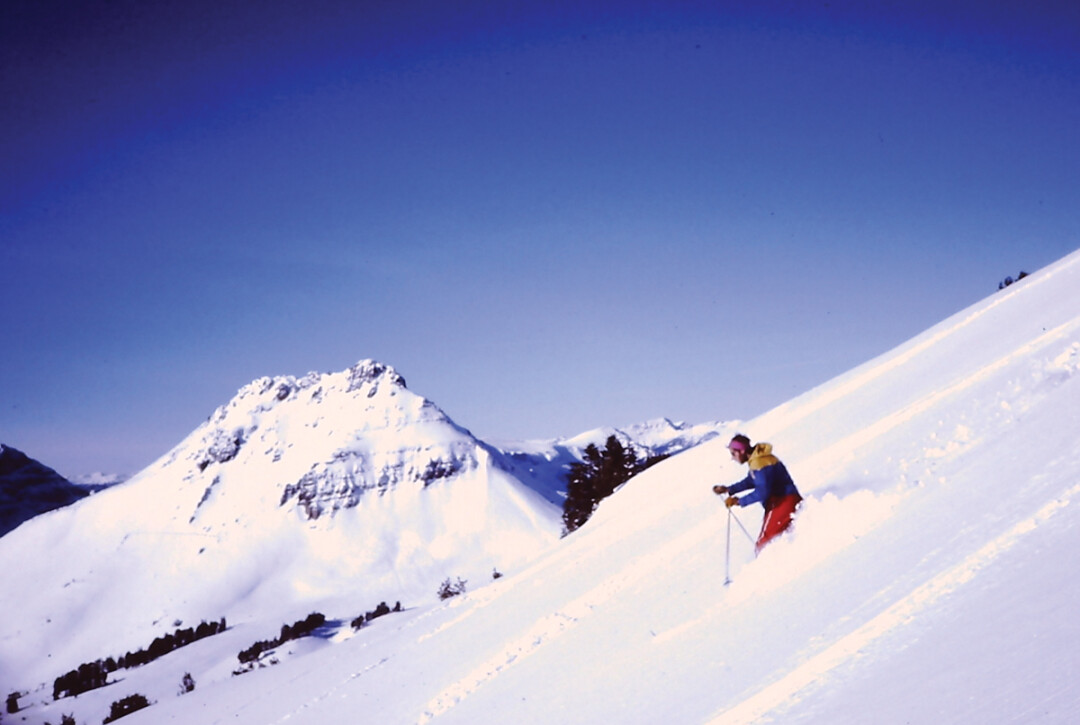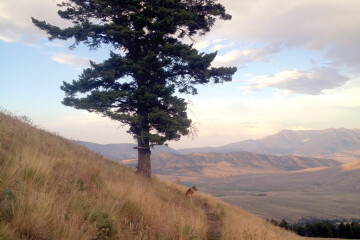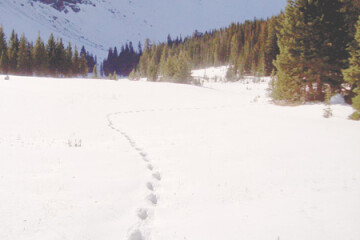The Pursuit of Peace & Powder

Silence. When was the last time you heard it? Do we even know what it is any more?
To me, silence is not a lack of sound; it is the presence of only natural sound. The hush of falling snow, tickling your cheeks, making tiny tack tack sounds on your parka’s hood and sliding down from the sky like frozen feathers. The whooosh of the wind in the rubbery, waving branches of a gnarled limber pine. The distant keening of a Clark’s nutcracker. The chuffing of your friend’s breath as you grunt up the skin track for one more shot of powder.
Silence, for me, equals tranquility. There’s a state of mind silence brings, a connection with the wider universe, and an understanding of deeper mysteries. Hearing only the chatter of chickadees, the patter of rain, the joyful yipping of coyotes, or the insistent hoot of an owl sustains me through the roar of I-90 truck traffic, the commotion of Bozeman construction noise, the harsh insistence of backup beepers, the thumping of car stereos, the endless drone of the machine-powered life we have imposed on the land and ourselves.
Natural soundscapes may well be essential to human health and well-being. Time spent listening to natural sound, or simply to the hum of deep silence, is healing and satisfying on a deep level.
Most cities register an average of 50 to 60 decibels of noise. Noise activates our stress hormones and raises our blood pressure. Personally, I react strongly to sudden loud noise, such as the roar of a large diesel truck or the crack of fireworks. It’s the fight or flight response. Animals make it obvious – who has not seen a dog cower or run when fireworks go off nearby?
All animals can hear, though not all can see. Hearing is the one sense we cannot easily turn off, so perhaps it is the most important sense. Many animals such as bats and owls have far more sensitive hearing than we do, and need to hear those tiny noises – the crunch of leaf or rustle of grass or echoing chirp – to locate their food. Unnecessary commotion drowns out those important cues.
Thankfully we live close to wide swaths of wild country like the Beartooth Mountains or the Gallatin Range, where nature holds sway as best she can and natural sounds still dominate. But even there, in the remotest places, it’s difficult to entirely escape human caused noise.
I’ve been blessed to play in some very remote places. Some of them are no longer quiet and remote.
My ski pals and I made many road trips through the winter world of Yellowstone to the end of the road, at Cooke City, Montana. Here we’d park the old jalopy, struggle into leather ski boots, clip toes into three-pin bindings, hoist hefty loads onto our young shoulders, buckle waist belts around bellies full of bacon and eggs, and start the uphill shuffle toward Daisy Pass. An occasional snow machine would putter past us, and we would feel superior as we strained our muscles toward our goal.
Four miles in, as the trees dwindled down and the peaks presented their snowy summit ridges, we’d veer off the path and head for our hidden shelter, the Horn Miller Cabin. Built in the 1880s by Adam “Horn” Miller, the cabin still stood and was free and open to use. With a small woodstove and a couple of bunks, the little cabin served us well and provided unbelievable access to epic stashes of untracked snow on Mount Henderson, Miller Mountain, Crown Butte, Fisher Mountain and other peaks further afield. Climbing on old military surplus skins, we earned every turn, every foot of elevation and every spectacular view of the wild, rugged Beartooth Range.
When I go back to the Beartooths now, it’s much harder to find untracked snow and quiet places. The advent of high-powered snow machines has completely transformed the area around Daisy Pass and Lulu Pass that we used to ski. Machines track out all accessible snow, and high-markers on souped-up sleds blast up the middle of the steepest bowls, the howl of their engines echoing through the mountains like enraged beasts. To get away from the machines you need to travel into designated Wilderness, which I admit can be found to the south of town. But our old haunts, where my friends and I cut our teeth on backcountry skiing, have been taken away by people with expensive, high-impact motorized toys.
Bozeman residents are in general very fit, active and motivated, and many of us still prefer to work for our fun. Terrain around here is unforgiving, and it’s often a real hump to get where you want to go. But greater effort yields greater rewards. I get a great deal of satisfaction from traveling via the power of my own not so young muscles. Using what evolution gave you shows a lot of class. It also helps keep you fit and helps delay the onset of age and infirmity.
I’m sorry, but unless you are disabled, using a motor for your backcountry recreation is lazy and lame. The land is shrunken by the use of motors, and your impact – noise, erosion, air pollution - is spread much further. It’s way more rad to travel silent and deep, like the critters do, staying stealthy and healthy, and exerting your own blood sweat and tears as you seek the high lonesome.
Let’s keep our public lands like the Gallatin Range and the Madisons as quiet as possible, to offer refuge from the clang and clatter of the human horde for the good of wild animals and our own wild selves.



